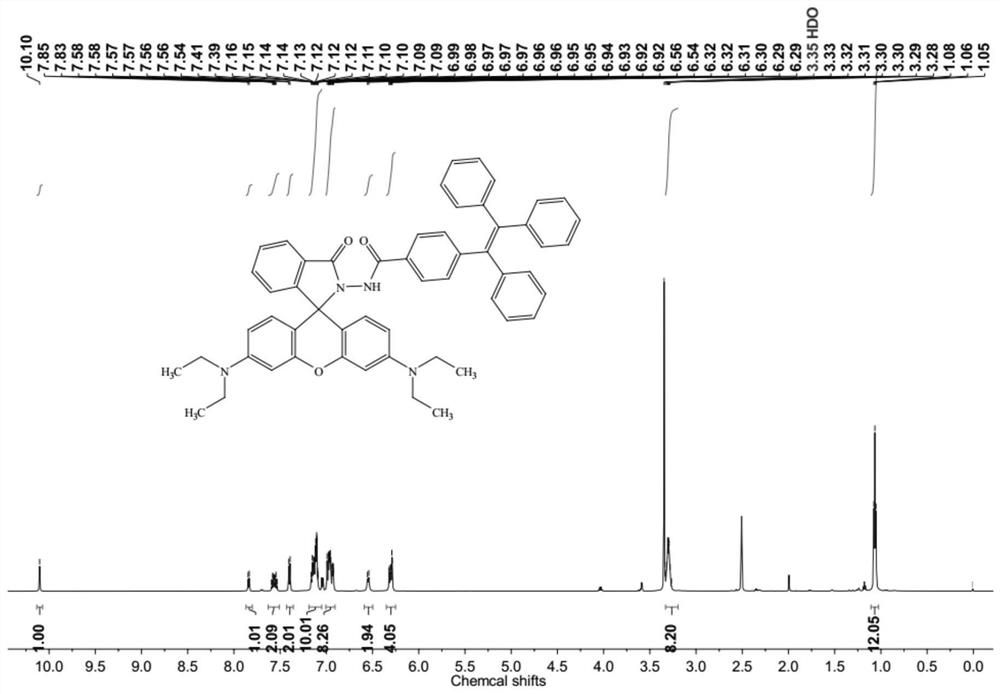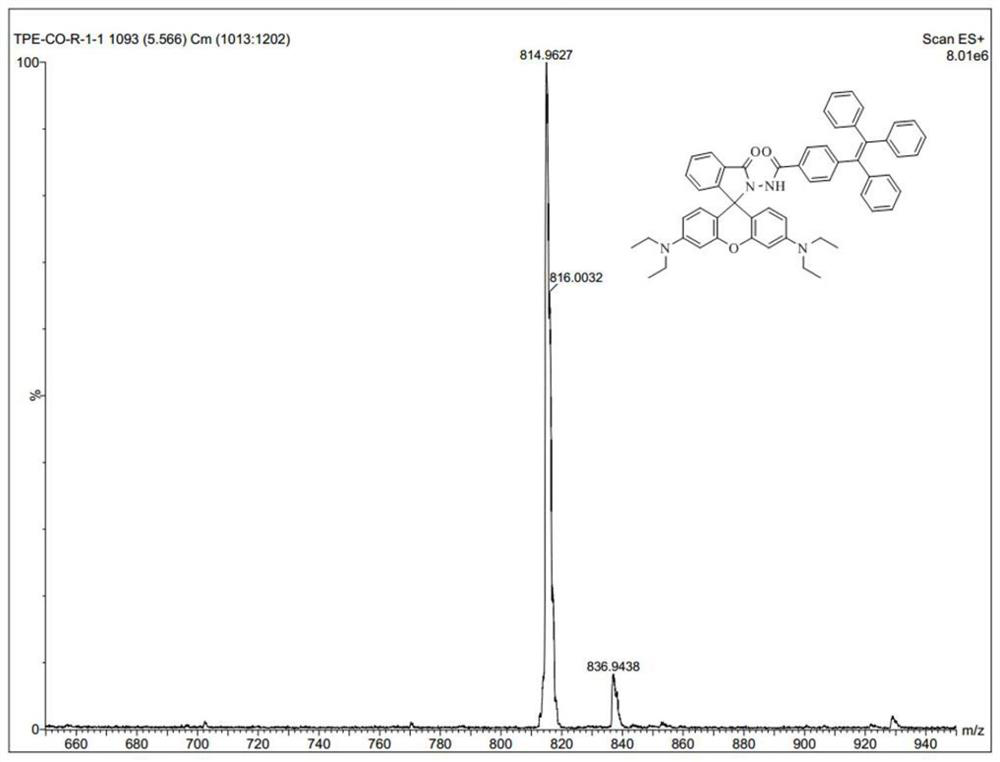Colorimetric/fluorescent probe for detecting hypochlorite ions as well as preparation method and application of colorimetric/fluorescent probe
A fluorescent probe and hypochlorite technology, applied in the direction of fluorescence/phosphorescence, chemical instruments and methods, luminescent materials, etc., can solve the problems of rare ClO-real-time quantitative fluorescence imaging, and achieve real-time quantitative fluorescence imaging and synthetic routes Short, easy cell staining effect
- Summary
- Abstract
- Description
- Claims
- Application Information
AI Technical Summary
Problems solved by technology
Method used
Image
Examples
Embodiment 1
[0041] Embodiment 1: the synthesis of probe compound TPE-acylamide-Rh
[0042] Weigh 0.50g (1.33mmol) of 1-(4-formylphenyl)-1,2,2-triphenylethylene and add it to 5mL of thionyl chloride solution, heat to reflux for 4h; sulfoxide solution. When the temperature dropped to room temperature, 30 mL of acetonitrile solution was added, followed by 1 mL of triethylamine; finally, 0.62 g (1.37 mmol) of rhodamine B hydrazide was weighed and added to the reaction solution, under nitrogen protection, heated to reflux, and reacted overnight. After the reaction was completed, the reaction solution was poured into water, extracted three times with dichloromethane, the organic phases were combined, dried over anhydrous magnesium sulfate, and spin-dried to obtain a crude product, using dichloromethane: methanol volume ratio of 30:1 as mobile phase, passing through silica gel The column yielded 0.35 g of pure product, yield: 31.4%, melting point: 173-175°C. Hydrogen spectrum such as figure 1...
Embodiment 2
[0043] Example 2: Ratio-type fluorescence characteristics and AIE properties of the probe TPE-acylamide-Rh
[0044] The probe TPE-acylamide-Rh is a ClO with AIE characteristics linked by tetraphenylethylene and rhodamine B through an amide bond - fluorescent probe. The recognition site of the probe TPE-acylamide-Rh is the rhodamine amide structure, which is in the ClO - Under the action of strong oxidation, the amide bond is broken, the rhodamine spirocycle undergoes a "ring-opening reaction", and the colorimetry / fluorescence of the probe changes. The probe TPE-acylamide-Rh exhibits the fluorescence of tetraphenylethylene in the aggregated state, and when mixed with ClO - After the reaction, the tetraphenylethylene aggregation-induced luminescence of the probe disappears, showing the fluorescence of the rhodamine structure, becoming a typical ratiometric fluorescent probe.
[0045] The probe TPE-acylamide-Rh exhibits typical aggregation-induced luminescent properties (e.g. ...
Embodiment 3
[0046] Embodiment 3: Solvent ratio selection of probe TPE-acylamide-Rh
[0047] TPE-acylamide-Rh is a reactive ClO - For fluorescent probes, the choice of solvent ratio affects the sensitivity of the probe. Test the addition of ClO to ethanol-water systems with different water contents - Fluorescence intensity to explore the optimal solvent ratio, the results are as follows Figure 5 shown. The water content of TPE-acylamide-Rh solution is between 0% and 50%, in a dissolved state, no fluorescence emission, in ClO - Under the action, a fluorescence emission peak appears at 583nm, and the intensity of the emission peak is the largest when the water content is 50%, indicating that: TPE-acylamide-Rh is in solution state for ClO - Has good sensitivity, in the ethanol-water system with a water content of 50%, for ClO - The response sensitivity is the highest. Therefore, TPE-acylamide-Rh reacts to ClO in solution state - The identified solvent ratio is 50% ethanol-water syste...
PUM
 Login to View More
Login to View More Abstract
Description
Claims
Application Information
 Login to View More
Login to View More - R&D
- Intellectual Property
- Life Sciences
- Materials
- Tech Scout
- Unparalleled Data Quality
- Higher Quality Content
- 60% Fewer Hallucinations
Browse by: Latest US Patents, China's latest patents, Technical Efficacy Thesaurus, Application Domain, Technology Topic, Popular Technical Reports.
© 2025 PatSnap. All rights reserved.Legal|Privacy policy|Modern Slavery Act Transparency Statement|Sitemap|About US| Contact US: help@patsnap.com



